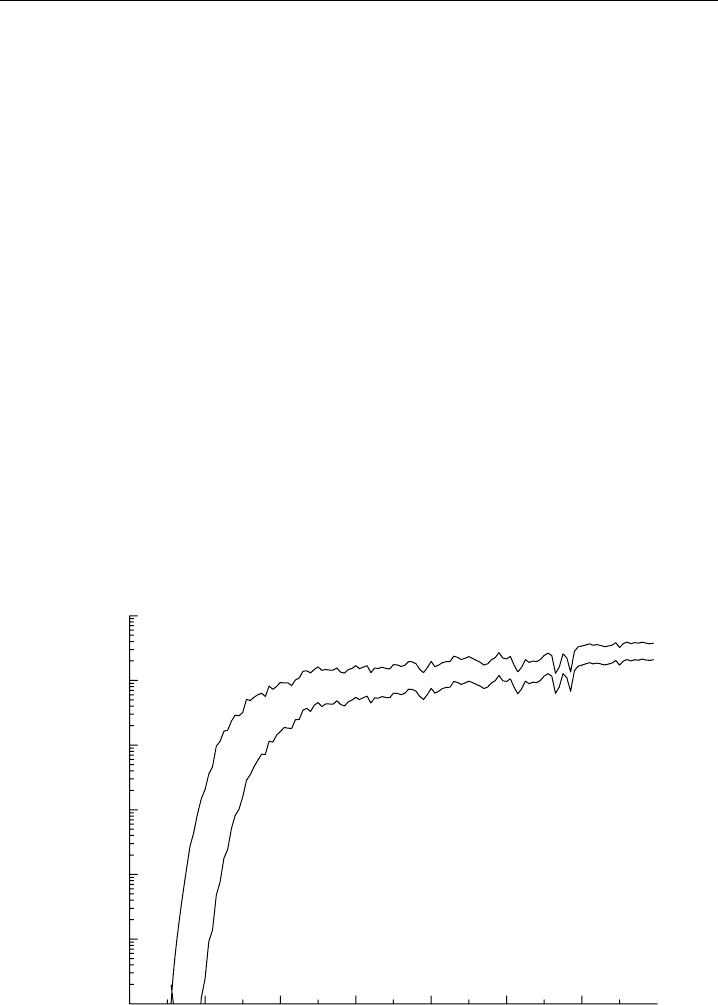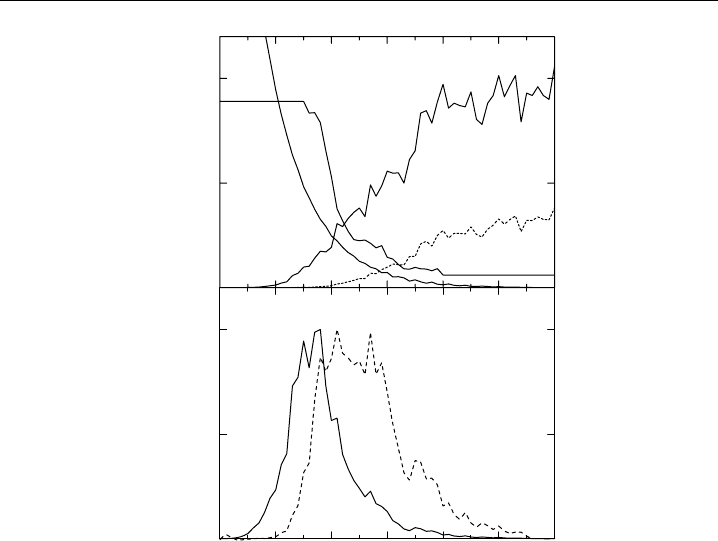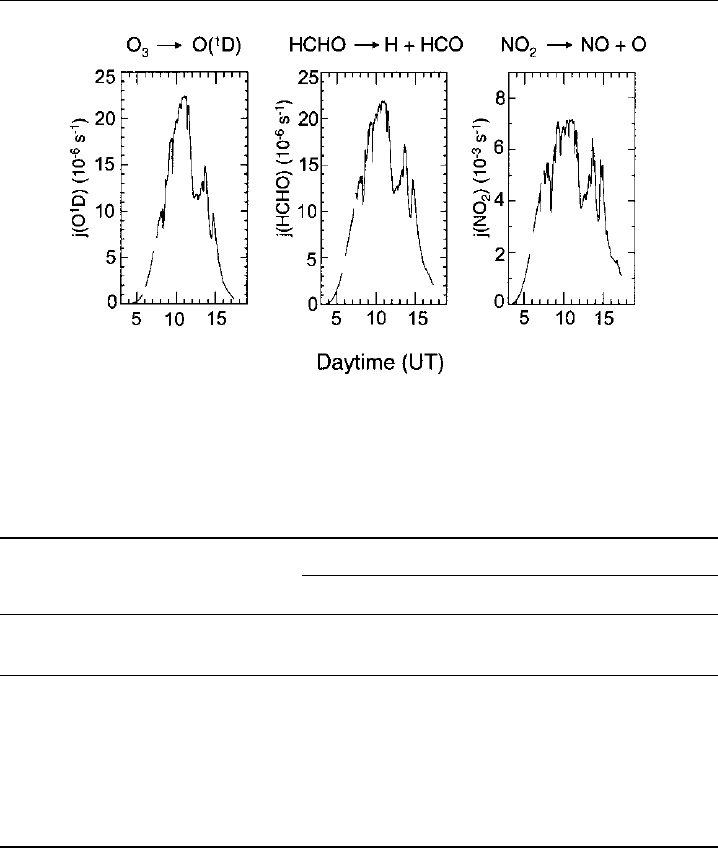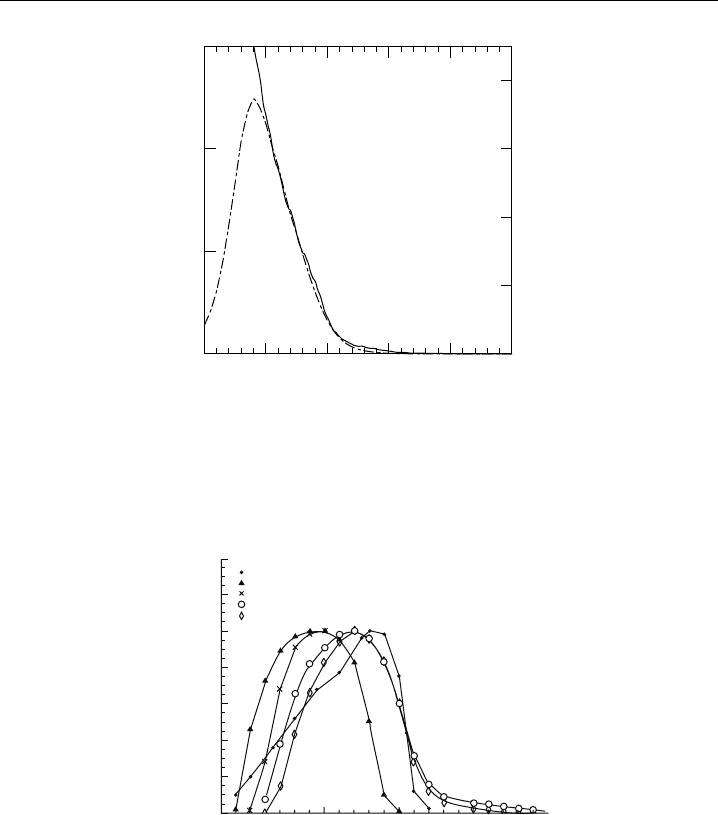Heard D.E. (editor) Analytical Techniques for Atmospheric Measurement
Подождите немного. Документ загружается.


448 Analytical Techniques for Atmospheric Measurement
Monks, 2003; Jäkel et al., 2005). In the field, varying environmental conditions may
influence the stability of the radiometer calibration. Possible sensitivity changes can be
monitored by periodical field checks using secondary calibration standards (e.g. 200 W
lamps).
9.4.5.3 Wavelength calibration
The wavelength scale of a spectroradiometer is usually calibrated by measuring the
spectrum of atomic emission-lines at well-known wavelengths (e.g. from a low-pressure
mercury lamp). Monochromator systems can measure the spectra by scanning the
monochromator wavelength with small incremental steps, which are much narrower than
the spectrometer bandwidth. The resulting spectrum represents the slit function of the
monochromator, which normally looks triangular- or Gaussian-shaped and possesses a
well-defined maximum (cf. Appendix A.3). The position of the maximum can then be
assigned to the known wavelength of the emission line. The resulting wavelength accuracy
for the scanning spectrometers in Table 9.5 is generally better than 0.1 nm.
When a spectrograph system measures an atomic emission line, the measured spectrum
will display the instrumental line shape sampled with the resolution given by the pixel-
to-pixel distance. The maximum of the observed line shape is then assigned to the atomic
emission wavelength. If the number of pixels covering the line width is too small, the
position of the maximum cannot be determined accurately. In this case, it makes sense
to fit a function (e.g. parabola or gaussian) to the measured line spectrum to obtain an
improved estimate of the line position. For example, the pixel distance of the spectrograph
in Figure 9.18 is only 0.8 nm, but a wavelength accuracy of less than 0.3 nm can be
specified (Zeiss GmbH, 1998).
In field applications, the stability of the wavelength calibration is an important
instrumental feature. Stability can be provided by a temperature stabilisation of
scanning monochromators, which are generally susceptible to temperature effects of their
mechanical wavelength-drive. Spectrographs are inherently more stable because they have
no moving parts. The instrument in Figure 9.18, for example, has a ceramic body to
which all optical components have been cemented, resulting in a negligible temperature
drift of <00005 nm ·K
−1
(Zeiss GmbH, 1998). The wavelength accuracy of measured
atmospheric spectra can be additionally controlled by correlating the Fraunhofer structure
in the measured spectra versus reference spectra obtained from the extraterrestrial solar
spectrum. Different mathematical procedures have been developed for that purpose by
different research groups (see for example McKenzie et al., 1992; Slaper et al., 1995).
9.4.6 Determination of photolysis frequencies
Photolysis frequencies can be calculated from measured actinic-flux spectra according to
Equation 9.29. First, the spectral distribution of the photolysis frequency is calculated,
× ×F
, which is then integrated (summed up) to obtain the respective
j-value. The required absorption cross sections, , and quantum yields, , are generally
taken from the literature (see references in Section 9.8.4).

Measurement of Photolysis Frequencies in the Atmosphere 449
9.4.6.1 Examples
Figure 9.22 shows two examples of actinic-flux spectra that were measured with a scanning
double-monochromator system on a cloud-free day in Boulder, Colorado, in June 1998.
The wavelength dependence between 280 and 420 nm is displayed for two solar zenith
angles, =16
(local noon) and 75
(late afternoon). In both spectra, the solar radiation
decreases sharply at wavelengths below 320 nm, caused by atmospheric ozone absorption,
with an apparent shift of the UV-B cut-off towards longer wavelength when the solar
zenith angle increases. At wavelengths between 320 and 420 nm, the spectra show relative
weak wavelength dependencies, with spectral structures caused by solar Fraunhofer lines.
The cross sections and quantum yields for the formation of O
1
D by ozone photolysis
are shown in the upper part of Figure 9.23 together with the solar spectra from the
previous figure. The lower part of Figure 9.23 shows the resulting spectral distributions
of the photolysis frequency jO
1
D. The photolysis is limited at short wavelength by the
available solar radiation, and at long wavelength by the decrease of ×. It is interesting
to note that the nearly exponential rise of the O
3
absorption cross section towards shorter
wavelength gives high spectral weight to the strongly decreasing photon fluxes. As a result,
the radiation in the UV-B cut-off region (290–310 nm) makes a significant contribution
to jO
1
D.
Photolysis-frequency distributions of other photochemically relevant molecules are
presented in Figure 9.24. It shows the different spectral weighting of the solar radiation
by the individual photolysis processes. The different weighting is the main reason for
different zenith-angle dependencies of the photolysis frequencies and their different
280 300 320 340 360 380 400 420
10
15
10
14
10
13
10
12
10
11
10
10
10
9
χ
= 16°
χ
= 75°
Actinic flux, F
λ
(cm
–2
s
–1
nm
–1
)
Wavelength (nm)
Figure 9.22 Actinic-flux spectra measured on a cloud-free day at two different solar zenith angles. The
spectra were recorded with a double-monochromator–based spectroradiometer during the IPMMI field
campaign in Boulder, Colorado, on 19 June, 1998, by Forschungszentrum Jülich.

450 Analytical Techniques for Atmospheric Measurement
0.0
0.5
1.0
σ
O
3
F
λ
(χ = 75°)
F
λ
(χ = 16°)
Φ
O
1
D
rel. units
290 300 310 320 330 340 350
0.0
0.5
1.0
× 31
Wavelength(nm)
σ
O
3
Φ
O
1
D
F
λ
(rel. units)
Figure 9.23 (a) Wavelength dependencies of the ozone absorption cross-section
O
3
and O
1
D
quantum yield
O1D
at 298 K, and the actinic flux F
at two different zenith angles.
O
3
(in units
of 42 ×10
−19
cm
2
) is from Malicet et al. (1995),
O
1
D
is from Talukdar et al. (1998). F
(in units
of 167 ×10
14
cm
−2
s
−1
nm
−1
) is from Figure 9.22. (b) Spectral distribution of jO
1
D (in units of 3 ×
10
−6
s
−1
nm
−1
)at = 16
(solid line) and 75
(dashed line) (adapted from Hofzumahaus et al., 2004,
printed with permission from American Geophysical Union).
responses to changes in total ozone, aerosol, and clouds. Figure 9.25 shows as an example
the diurnal profiles of photolysis frequencies of O
3
, HCHO, and NO
2
, derived from the
same time series of actinic-flux measurements on a partly cloudy day. The profiles of the
three compounds are differently broad and show different temporal modulations caused
by clouds. This demonstrates that in general photolysis frequencies of different chemical
compounds cannot be scaled to each other, but must be determined individually.
9.4.6.2 Accuracy
Photolysis frequencies derived from spectroradiometer measurements have errors that
arise from different sources (Table 9.6). The uncertainty of the absolute detection sensi-
tivity D
0
×Z
H
is generally in the order of 5–8%, which is more or less wavelength
independent. In contrast the spectrometer bandwidth and the wavelength error contribute
differently to the uncertainty of j-values, depending on the spectral range where the
photolysis process occurs. For example, jO
1
D values show the largest sensitivity to

Measurement of Photolysis Frequencies in the Atmosphere 451
Wavelength(nm)
NO
2
NO + O
300 320 340 360 380 400280 420
0.0
0.5
1.0
0.0
0.5
1.0
0.0
1.0
2.0
0.0
1.0
0.0
1.0
0.5
0.0
0.5
×
10
–6
× 10
–7
× 10
–6
× 10
–7
× 10
–4
× 10
–4
HONO OH + NO
H
2
O
2
OH + OH
HCHO
H
+ HCO
CH
3
CHO
CH
3
+
HCO
O
3
O(
1
D)
σ (λ) φ (λ) F
λ
(λ) (s
–1
nm
–1
)
Figure 9.24 Spectral distribution of photolysis frequencies, × ×F
, for different photolysis
reactions. The actinic flux F
was measured at ground in North-East Germany at a solar zenith angle of
53
(adapted from Kraus and Hofzumahaus, 1998, with kind permission of Springer Science and Business
Media).
the bandwith selection and wavelength error, because the two parameters have a strong
influence on how reliable the steep spectral gradient at 290–310 nm can be measured.
Stray light is generally no problem for double-monochromator systems. Spectrograph
systems, however, have a high stray-light background for which the measured spectra must
be corrected (see Section 9.4.2). The residual error is generally negligible for photolysis
frequencies, which are dominated by spectral contributions from above 310 nm, for
example jNO
2
. The accurate determination of jO
1
D values, however, is problematic
and residual errors after stray-light corrections can be 10% or higher (Edwards & Monks,
2003; Kanaya et al., 2003; Eckstein et al., 2003; Jäkel et al., 2005). Since spectrograph
systems offer a number of advantages compared to scanning systems, more accurate
methods for the stray-light correction in the UV-B are highly desirable and remain subject
to ongoing research (e.g. Ylianttila et al., 2005).

452 Analytical Techniques for Atmospheric Measurement
Figure 9.25 Diurnal profiles of the photolysis frequencies for O
3
, HCHO, and NO
2
. The j-values were
measured at ground on a cloudy day (10 August, 1994) in North-East Germany. Local noon was at
11:20 UT (adapted from Kraus and Hofzumahaus, 1998, with kind permission of Springer Science and
Business Media).
Table 9.6 Error contributions to j-values derived from spectral actinic-flux measurements
Error contribution (%)
Source of error
jO
1
Dj(HCHO) jNO
2
Absolute sensitivity 5–8
a
Stray light correction Instrument dependent
b
Spectrometer bandwidth
c
1nm +08 −16 −008
2nm +31 −29 −014
Wavelength accuracy
c
±01nm ±23 ±08 ±016
a
±3 ±10 ±4
a
±10 ±12 ±10
a
See for example Kraus and Hofzumahaus (1998); Shetter et al. (2003); Hofzumahaus et al. (2004).
b
Negligible for double-monochromator systems.
c
See discussion in Hofzumahaus et al. (1999); values apply to a solar zenith angle of 30
.
A considerable uncertainty of the photolysis frequencies comes from the errors of the
molecular parameters (Kraus & Hofzumahaus, 1998). Although published absorption
cross sections have been measured in some cases with high accuracy (e.g. <3% for O
3
),
quantum yield data are on principle more difficult to measure and usually not better
known than 10%. Care must be exercised about which published data set is the most
suitable for the determination of photolysis frequencies. This question has been addressed
in field studies where photolysis frequencies from spectroradiometers were compared to
measurements by chemical actinometers. For details, see Section 9.8.4.

Measurement of Photolysis Frequencies in the Atmosphere 453
9.5 Actinic-flux filter radiometry
Filter radiometry is a special case of broadband radiometry, that is the measurement
of radiation in an intentionally broad spectral interval (e.g. McCluney, 1994), where an
optical transmission filter is used to confine the wavelength range that is measured by
a photosensitive detector. Most commercially available broadband radiometers measure
irradiances with a spectrally flat response, so that the radiation falling into the sensitivity
range of the instrument is measured as an integral quantity in units of W·m
−2
. Examples
are pyranometers that are used in meteorology for the measurement of the total irradiance
from the sun and the sky. There exists another class of broadband radiometers that apply
spectral weighting curves resembling the photoresponse of a specific chemical, physical
or biological system. An example is the widely used Robertson-Berger UV radiometers,
which measure the solar irradiance with a spectral response proportional to the UV-
induced erythemal (sunburning) potential of the human skin (Berger, 1976).
Actinic-flux filter radiometers belong to the class of instruments that produce a
signal proportional to a photochemical effect. The concept was first introduced for the
measurement of atmospheric photolysis frequencies by Junkermann et al. (1989). They
combined a receiver optic, which collects radiation with isotropic sensitivity, with combi-
nations of optical filters and photoelectric sensors to build instruments for the specific
measurement of jO
1
D and jNO
2
. The optical wavelength selection was matched closely
to the spectral function × of the respective photolysis frequency, resulting
in an output signal proportional to j. The instruments were then calibrated absolutely
by comparison against chemical actinometer measurements. Since the latter half of
1990s, actinic-flux filter radiometers have been more widely used, after they became
commercially available from a manufacturer (Meteorologie Consult GmbH, Glashütten,
Germany).
Another concept of broadband filter-radiometry uses a cubic array of six, flat radiation
sensors to approximate isotropic detection of solar radiation (Lindh et al., 1964; Nader &
White, 1969; Van der Hage et al., 1994; Kylling et al., 2003b). Such radiometers have been
used in field experiments at ground or suspended under balloons to study the actinic
flux in the atmosphere, but were not designed to provide specific photolysis frequencies.
Therefore, they will not be further treated here.
In principle, filter radiometers refer specifically to single photolysis reactions. The main
advantage of filter-radiometer devices is that they are small and lightweight, and can be
operated automatically providing continuous data sets with high time resolution. As will
be discussed below, calibration in terms of photolysis frequencies is a laborious task and
care has to be exercised in the signal evaluation for accurate results.
9.5.1 Filter radiometer set-up
The general construction of an actinic-flux filter radiometer is illustrated in Figure 9.26.
The inlet optic collects solar radiation from one hemisphere with nearly uniform response
and couples the light into a light-guide, which directs the radiation through a collimator
and an optical transmission filter for detection by a photoelectric sensor. The design
of the receiver optic is essentially the same as described in Section 9.4.3 for use in

454 Analytical Techniques for Atmospheric Measurement
ϑ
a
f
b
c
d
e
ϕ
Figure 9.26 Schematic diagram of the instrumental set-up of a jO
1
D filter radiometer: a, quartz diffuser;
b, quartz light-guide; c, collimator; d, optical filter; e, photomultiplier tube; f, shadow ring (from Bohn
et al., 2004, printed with permission from American Geophysical Union).
spectroradiometry. The components of the filter–detector combination are chosen to
match the photolysis frequency of interest as close as possible. For the measurement of
jO
1
D, an interference filter with a centre wavelength of 300 nm and a bandpass of 10 nm
(FWHM) is usually combined with a solar-blind photomultiplier (CsTe photocathode;
160–320 nm) to simulate the wavelength dependence of
O
3
×
O
1
D
in the spectral region
that is relevant for the troposphere (>300 nm; see Figure 9.27) (Junkermann et al., 1989;
Bohn et al., 2004). In order to avoid a temperature-dependent wavelength-shift of the
filter curve, the corresponding radiometer parts are usually kept at constant temperature.
The measurement of jNO
2
requires an optical filter with a broad bandpass of
∼100 nm covering the wavelength range in which NO
2
photodissociates (cf. Figure 9.24).
Since the integral photon-flux is high, a vacuum photodiode (Sb-Cs photocathode;
185–650 nm) with a relatively low detection sensitivity can be used, rather than a high-gain
photomultiplier that is needed for the determination of jO
1
D. Different combinations
of coloured glass filters were tested by Volz-Thomas et al. (1996) for their suitability to
mimic the spectral behaviour of jNO
2
, including the filter combination (1 mm WG305
+ 1 mm UG11) originally developed by Junkermann et al. (1989) (Figure 9.28). A signif-
icantly improved match for jNO
2
was achieved with a filter combination (2 mm UG3
+ 1 mm UG5) that has been adopted for most jNO
2
filter radiometers.
The instruments normally include a transimpedance amplifier with a fixed gain that
converts the photocurrent of the detector into an analogue voltage signal U which can
be recorded automatically by a data logger. The response time of the radiometer can be
made fast, 1 s or less, depending on the required time resolution.
The design of the filter radiometers allows measurements from one hemisphere only.
Two radiometers must be employed if 4 sr photolysis frequencies are required. In this
case, the instruments are oriented in opposite directions, one viewing upward and one
downward as illustrated in Figure 9.8.

Measurement of Photolysis Frequencies in the Atmosphere 455
290 300 310 320 330 340
Wavelength (nm)
0.0
0.4
0.8
1.2
0.0
1.0
2.0
3.0
4.0
σ (O
3
) φ (O
1
D)/10
–19
cm
2
Relative sensitivity
Figure 9.27 Relative spectral sensitivity D
rel
of a jO
1
D filter radiometer (dashed line, left axis) and
product
O
3
×
O
1
D
at a temperature of 295 K (full line, right axis) (Malicet et al., 1995; Talukdar et al.,
1998). The relative wavelength dependencies of the curves agree well in the spectral region that is
relevant for the troposphere at >300 nm (from Bohn et al., 2004).
Wavelength (nm)
Relative sensitivity (%)
300
140
120
100
80
60
40
20
0
350 400 450 500
[1 mm WG305, 1 mm UG11] = A
[1
mm WG320, 1 mm UG11] = B
[1
mm UG3, 1 mm UG5] = C
[2
mm UG3, 1 mm UG5] = D
σ * φ
Figure 9.28 Relative spectral sensitivity D
rel
of a jNO
2
filter radiometer for different glass filter combi-
nations. Also shown is the product
NO
2
×
NO+O
(Davidson et al., 1988; Gardner et al., 1987) (from
Volz-Thomas et al., 1996).
9.5.2 Determination of photolysis frequencies
The voltage signal of a broadband radiometer can be understood as the spectral signal
U
integrated over the whole wavelength range that contributes to the signal:
U =
U
d (9.40)

456 Analytical Techniques for Atmospheric Measurement
The relation between U
and the incident actinic flux can be expressed in analogy to the
description of a spectroradiometer signal I
(see Section 9.4.4, Equation 9.34) as:
U
= D
0
Z
H
F
(9.41)
Here, the symbols D
0
and Z
H
have the same meaning as in Equation 9.34, where
D
0
is the absolute spectral sensitivity of the radiometer and Z
H
is a correction factor
for possible deviations from the isotropic response of the receiver optic. It should be
noted, however, that in this case D
0
refers to a signal which is a voltage.
Assuming that Z
H
is nearly wavelength independent over the spectral interval relevant
for jO
1
D and jNO
2
, Equations 9.40 and 9.41 can be combined as follows:
U = Z
H
D
0
F
d (9.42)
D
0
can be further factorised into a dimensionless function D
rel
, which represents
the relative sensitivity of the filter–detector combination as a function of wavelength, and
an absolute scaling factor D
abs
:
D
0
= D
abs
D
rel
(9.43)
If this expression is inserted into Equation 9.42, the following relationship between U
and the actinc flux is obtained:
U = D
abs
Z
H
D
rel
F
d (9.44)
In this equation the product D
abs
×Z
H
is a wavelength-independent factor, while the
integral represents the total actinic flux weighted by the spectral radiometer response.
Assuming that the photolysis process of interest is driven by the same radiation that is
responsible for the radiometer output, the photolysis frequency j will be proportional to
the radiometer signal U:
j = AU (9.45)
If the factor A is known, then j can be derived from U according to this equation. In the
most simple and ideal case, A has a constant value that can be obtained by a calibration.
However, in practice, A is more or less dependent on ambient parameters (e.g. solar
zenith angle or air temperature), which must be considered in the accurate evaluation of
the j-values.
In order to understand which quantities influence the value of A, Equations 9.44 and
9.12 can be inserted into Equation 9.45 which yields the following equation for A:
A =
j
U
=
1
D
abs
Z
H
F
d
D
rel
F
d
(9.46)

Measurement of Photolysis Frequencies in the Atmosphere 457
The expression on the right side of the equation will be constant only, if the product
D
abs
×Z
H
has a fixed value and the ratio of the two integrals is invariable. The latter
condition applies if
•
the radiometer response and the cross section of the photodissociation show the same
relative wavelength dependence, that is D
rel
∝ ;or
•
the shape of the actinic-flux spectrum F
remains the same, except for a wavelength-
independent scaling factor, for all atmospheric conditions.
Neither of these conditions is fulfilled. In all practical cases, the spectral response of
the radiometer does not match exactly the shape of ×. As a result, the ratio
of the photolysis frequency and the radiometer signal varies as the spectral distribution
of the actinic flux changes with ambient conditions. The most influential parameters
that need to be considered are the solar zenith angle , the total atmospheric ozone
t
O
3
(if radiation below 320 nm is significantly involved), and the measurement altitude
h (Junkermann et al., 1989; Volz-Thomas et al., 1996; Bohn et al., 2004). A further
general complication arises, if × or D
abs
×D
rel
depends on temperature. Then the
corresponding influence of the air temperature, T , and the radiometer temperature, T
R
,
on the ratio A = j/U must be considered also.
Accordingly, A is a variable quantity that can be generally described by a non-linear
function of different parameters p
i
:
A = Ap
i
with p
i
= t
O
3
TT
R
h (9.47)
For practical reasons A is separated into a constant factor A
0
at selected reference condi-
tions (p
0
i
=
0
t
0
O
3
T
0
T
0
R
h
0
) and a dimensionless function f describing the relative
dependence on the parameters p
i
:
A = A
0
fp
i
(9.48)
with
A
0
= Ap
0
i
and fp
0
i
= 10 (9.49)
Using these definitions, j can be related to the radiometer signal U by
j = A
0
fp
i
U (9.50)
Here, A
0
can be understood as a constant linear calibration factor for selected reference
conditions and f as a correction function accounting for the non-linear deviations in
the relationship between j and U when the ambient parameters p
i
change relative to
the reference conditions. As will be shown below, typical f values reported for jO
1
D
radiometer applications in the troposphere deviate from unity by up to a factor 2, but
usually less than 10% for jNO
2
radiometers (Sections 9.5.4 and 9.5.5).
